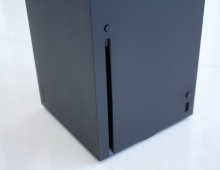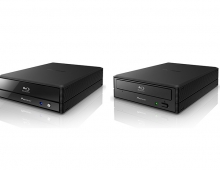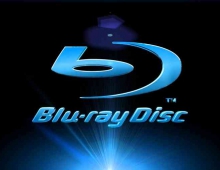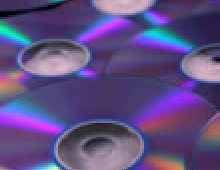
Hybdid discs to support "blue" rivals
Since commercial winner is not clear yet, both "blue laser" camps develop their systems far beyond the target points they would be setting if there was a single agreed standard...
A lot of discussion has been made lately about the blue laser storage potentials. Major IT shows have showcased Blu-Ray and HD-DVD campaigns, and respectable amounts of money are expected to be spent for promotion the upcoming years. Whether this is an actual or a marketing motivated "war", the Movie industry seems to likely issue entertainment on both Blu-ray and HD-DVD formats until one emerges as the de-facto standard.
The first attempts to fill-in the gap between a real commercial working device and a theoretical prototype, are already in progress. Hybrid discs will be showcased in the upcoming Mediatech International Show.
Toshiba has worked with Memory-Tech to develop a dual layer HD-DVD with ordinary DVD data pressed into an upper layer, and HDTV in a lower layer. The 650nm red laser in a DVD player just reads the top layer; a 405nm blue laser focuses down to the HD layer. This, however, gives reduced capacities of 4.7GB (DVD) and 15GB (HD).
Cinram has made another approach. Cinram's HD/DVD-9 hybrid will have a traditional 8.5GB DVD, bonded back to back with a 15GB HD DVD blue laser disc.
"This product has excellent potential," said David Rubenstein, president and chief operating officer of Cinram International Inc. "The combination of a traditional DVD with the new high-definition format creates a new and exciting option for consumers with more features than ever. HD/DVD 9 is a great way to introduce consumers to the full experience of high-definition video".
Philips then claimed success in the labs with a rather complicated, however, system. A blue laser layer is molded into a 0.5mm substrate, a DVD layer molded into a 0.6mm substrate; both layers are sputtered with reflective layers and are glued back to front. An optical disc skin is applied and the hybrid is ready. What about manufacturing cost? Tough answer.
JVC follows with a tree-layer proposal. The disc will have blue laser top layer (25GB); underneath there are two more layers just like an ordinary DVD (8.5GB). Blue laser and DVD layers are separated by a semi-reflective film that reflects blue light but passes red light through the DVD layer underneath. So this way, Blu-Ray's double layer can be manufactured as double layer, without needing to produce a double line up for discs. So when you buy a DVD, it will be blue-ready waiting for a Blu-Ray player to be available.
JVC's proposal sounds smart but again, cost for pressing the same program material (ie movie) onto a single triple layer disc is questionable.
The first attempts to fill-in the gap between a real commercial working device and a theoretical prototype, are already in progress. Hybrid discs will be showcased in the upcoming Mediatech International Show.
Toshiba has worked with Memory-Tech to develop a dual layer HD-DVD with ordinary DVD data pressed into an upper layer, and HDTV in a lower layer. The 650nm red laser in a DVD player just reads the top layer; a 405nm blue laser focuses down to the HD layer. This, however, gives reduced capacities of 4.7GB (DVD) and 15GB (HD).
Cinram has made another approach. Cinram's HD/DVD-9 hybrid will have a traditional 8.5GB DVD, bonded back to back with a 15GB HD DVD blue laser disc.
"This product has excellent potential," said David Rubenstein, president and chief operating officer of Cinram International Inc. "The combination of a traditional DVD with the new high-definition format creates a new and exciting option for consumers with more features than ever. HD/DVD 9 is a great way to introduce consumers to the full experience of high-definition video".
Philips then claimed success in the labs with a rather complicated, however, system. A blue laser layer is molded into a 0.5mm substrate, a DVD layer molded into a 0.6mm substrate; both layers are sputtered with reflective layers and are glued back to front. An optical disc skin is applied and the hybrid is ready. What about manufacturing cost? Tough answer.
JVC follows with a tree-layer proposal. The disc will have blue laser top layer (25GB); underneath there are two more layers just like an ordinary DVD (8.5GB). Blue laser and DVD layers are separated by a semi-reflective film that reflects blue light but passes red light through the DVD layer underneath. So this way, Blu-Ray's double layer can be manufactured as double layer, without needing to produce a double line up for discs. So when you buy a DVD, it will be blue-ready waiting for a Blu-Ray player to be available.
JVC's proposal sounds smart but again, cost for pressing the same program material (ie movie) onto a single triple layer disc is questionable.





















